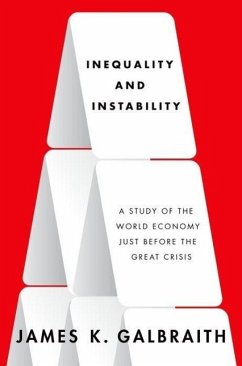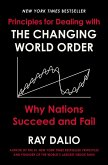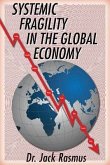James Kenneth Galbraith
Inequality and Instability
A Study of the World Economy Just Before the Great Crisis
Schade – dieser Artikel ist leider ausverkauft. Sobald wir wissen, ob und wann der Artikel wieder verfügbar ist, informieren wir Sie an dieser Stelle.
James Kenneth Galbraith
Inequality and Instability
A Study of the World Economy Just Before the Great Crisis
- Gebundenes Buch
- Merkliste
- Auf die Merkliste
- Bewerten Bewerten
- Teilen
- Produkt teilen
- Produkterinnerung
- Produkterinnerung
In this book, James K. Galbraith offers a vast expansion of the capacity to calculate measures of economic inequality both at lower and higher levels of aggregation. Breaking down traditional administrative boundaries to economic research, he provides a more sophisticated and more accurate picture of inequality around the world, and how inequality is one of the most basic sources of economic instability.
Andere Kunden interessierten sich auch für
![Eurotragedy Eurotragedy]() Ashoka Mody (Charles and Marie Robertson Visiting Professor in InteEurotragedy38,99 €
Ashoka Mody (Charles and Marie Robertson Visiting Professor in InteEurotragedy38,99 €![Creation and Destruction of Value P Creation and Destruction of Value P]() Dr. Harold JamesCreation and Destruction of Value P34,99 €
Dr. Harold JamesCreation and Destruction of Value P34,99 €![The Oxford Handbook of the Brazilian Economy The Oxford Handbook of the Brazilian Economy]() The Oxford Handbook of the Brazilian Economy197,99 €
The Oxford Handbook of the Brazilian Economy197,99 €![Principles for Dealing with the Changing World Order Principles for Dealing with the Changing World Order]() Ray DalioPrinciples for Dealing with the Changing World Order45,99 €
Ray DalioPrinciples for Dealing with the Changing World Order45,99 €![Systemic Fragility in the Global Economy Systemic Fragility in the Global Economy]() Jack RasmusSystemic Fragility in the Global Economy27,99 €
Jack RasmusSystemic Fragility in the Global Economy27,99 €![Understanding Global Crises Understanding Global Crises]() Thomas SadlerUnderstanding Global Crises53,99 €
Thomas SadlerUnderstanding Global Crises53,99 €![Geostrategy by Design Geostrategy by Design]() Courtney Rickert McCaffreyGeostrategy by Design22,99 €
Courtney Rickert McCaffreyGeostrategy by Design22,99 €-
-
-
In this book, James K. Galbraith offers a vast expansion of the capacity to calculate measures of economic inequality both at lower and higher levels of aggregation. Breaking down traditional administrative boundaries to economic research, he provides a more sophisticated and more accurate picture of inequality around the world, and how inequality is one of the most basic sources of economic instability.
Produktdetails
- Produktdetails
- Verlag: Oxford University Press Inc
- Seitenzahl: 336
- Erscheinungstermin: 30. März 2012
- Englisch
- Abmessung: 249mm x 164mm x 25mm
- Gewicht: 620g
- ISBN-13: 9780199855650
- ISBN-10: 019985565X
- Artikelnr.: 34925250
- Herstellerkennzeichnung
- Libri GmbH
- Europaallee 1
- 36244 Bad Hersfeld
- gpsr@libri.de
- Verlag: Oxford University Press Inc
- Seitenzahl: 336
- Erscheinungstermin: 30. März 2012
- Englisch
- Abmessung: 249mm x 164mm x 25mm
- Gewicht: 620g
- ISBN-13: 9780199855650
- ISBN-10: 019985565X
- Artikelnr.: 34925250
- Herstellerkennzeichnung
- Libri GmbH
- Europaallee 1
- 36244 Bad Hersfeld
- gpsr@libri.de
James K. Galbraith is the Lloyd M. Bentsen Jr. Chair in Government/Business Relations and Professor of Government at the LBJ School of Public Affairs at the University of Texas. He is the author most recently of The Predator State: How Conservatives Abandoned the Free Market and Why Liberals Should Too
* Chapter 1. The Physics and Ethics of Inequality
* 1. The Simple Physics of Inequality Measurement
* 2. The Ethical Implications of Inequality Measures
* 3. Plan of the Book
* References
* Chapter 2. The Need for New Inequality Measures
* 1. The Data Problem in Inequality Studies
* 2. Obtaining Dense and Consistent Inequality Measures
* 3. Grouping Up and Grouping Down
* 4. Conclusion
* References
* Chapter 3: Pay Inequality and World Development
* 1. What Kuznets Meant
* 2. New Data for a New Look at Kuznets' Hypothesis
* 3. Pay Inequality and National Income: What's the Shape of the Curve?
* 4. Global Rising Inequality: the Soros Super-bubble as a Pattern in
the Data
* 5. Conclusion
* References
* Appendix: On a Presumed Link from Inequality to Growth
* Chapter 4. Estimating the Inequality of Household Incomes
* 1. Estimating the Relationship Between Inequalities of Pay and Income
* 2. Finding the Problem Cases: A Study of Residuals
* 3. Building a Deep and Balanced Income Inequality Data Set
* 4. Conclusion
* References
* Chapter 5. Economic Inequality and Political Regimes
* 1. Democracy and Inequality in Political Science
* 2. A Different Approach to Political Regime Types
* 3. Analysis and Results
* 4. Conclusion
* References
* Appendix I: Political Regime Data Description
* Appendix II: Results Using Other Political Classification Schemes
* Chapter 6. The Geography of Inequality in America, 1969 to 2007
* 1. Between-Industry Earnings Inequality in the United States
* 2. The Changing Geography of American Income Inequality
* 3. Interpreting Inequality in the United States
* 4. Conclusion
* References
* Chapter 7: State-Level Income Inequality and American Elections
* 1. Some Initial Models Using Off-the-Shelf Data for the 2000
Election.
* 2. New Estimates of State-Level Inequality and an Analysis of the
Inequality-Elections Relationship over Time
* 3. Inequality and the Income Paradox in Voting
* 4. Conclusion
* References
* Chapter 8. Inequality and Unemployment in Europe: A Question of
Levels
* 1. An Inequality-based Theory of Unemployment
* 2. Region-based Evidence on Inequality and Unemployment
* 3. Inequality and Unemployment in Europe and America
* 4. Implications for Unemployment Policy in Europe
* References
* Appendix. Detailed Results and Sensitivity Analyses
* Chapter 9. European Wages and the Flexibility Thesis
* 1. The Problem of Unemployment in Europe: A reprise
* 2. Assessing Wage Flexibility Across Europe
* 3. Clustering and Discriminating to Simplify the Picture
* 4. Conclusion
* References
* Appendix A: Cluster Details
* Appendix B: Eigenvalues and Canonical Correlations
* Appendix C: Correlations between Canonical Scores and Pseudoscores
* Chapter 10: Globalization and Inequality in China
* 1. The Evolution of Inequality in China through 2007
* 2. Finance and the export boom, 2002 to 2006
* 3. Trade and capital inflow in post-WTO China
* 4. Profit and Capital Flows into Speculative Sectors
* 5. Conclusion
* References
* Chapter 11. Finance and Power in Argentina and Brazil
* 1. The Modern Political Economy of Argentina and Brazil
* 2. Measuring Inequality in Argentina and Brazil
* 3. Sources of Data
* 4. Pay Inequality in Argentina 1994-2007
* 5. Pay Inequality in Brazil 1996-2007
* 6. Conclusion
* References
* Chapter 12. Inequality in Cuba After the Soviet Collapse
* 1. Data on Pay in Cuba
* 2. Evolution of the Cuban Economy 1991 - 2005
* 3. Cuban Pay Inequality by Sector
* 4. Cuban Pay Inequality by Region
* 5. Conclusion
* References
* Chapter 13: Economic Inequality and the World Crisis
* Bibliography
* 1. The Simple Physics of Inequality Measurement
* 2. The Ethical Implications of Inequality Measures
* 3. Plan of the Book
* References
* Chapter 2. The Need for New Inequality Measures
* 1. The Data Problem in Inequality Studies
* 2. Obtaining Dense and Consistent Inequality Measures
* 3. Grouping Up and Grouping Down
* 4. Conclusion
* References
* Chapter 3: Pay Inequality and World Development
* 1. What Kuznets Meant
* 2. New Data for a New Look at Kuznets' Hypothesis
* 3. Pay Inequality and National Income: What's the Shape of the Curve?
* 4. Global Rising Inequality: the Soros Super-bubble as a Pattern in
the Data
* 5. Conclusion
* References
* Appendix: On a Presumed Link from Inequality to Growth
* Chapter 4. Estimating the Inequality of Household Incomes
* 1. Estimating the Relationship Between Inequalities of Pay and Income
* 2. Finding the Problem Cases: A Study of Residuals
* 3. Building a Deep and Balanced Income Inequality Data Set
* 4. Conclusion
* References
* Chapter 5. Economic Inequality and Political Regimes
* 1. Democracy and Inequality in Political Science
* 2. A Different Approach to Political Regime Types
* 3. Analysis and Results
* 4. Conclusion
* References
* Appendix I: Political Regime Data Description
* Appendix II: Results Using Other Political Classification Schemes
* Chapter 6. The Geography of Inequality in America, 1969 to 2007
* 1. Between-Industry Earnings Inequality in the United States
* 2. The Changing Geography of American Income Inequality
* 3. Interpreting Inequality in the United States
* 4. Conclusion
* References
* Chapter 7: State-Level Income Inequality and American Elections
* 1. Some Initial Models Using Off-the-Shelf Data for the 2000
Election.
* 2. New Estimates of State-Level Inequality and an Analysis of the
Inequality-Elections Relationship over Time
* 3. Inequality and the Income Paradox in Voting
* 4. Conclusion
* References
* Chapter 8. Inequality and Unemployment in Europe: A Question of
Levels
* 1. An Inequality-based Theory of Unemployment
* 2. Region-based Evidence on Inequality and Unemployment
* 3. Inequality and Unemployment in Europe and America
* 4. Implications for Unemployment Policy in Europe
* References
* Appendix. Detailed Results and Sensitivity Analyses
* Chapter 9. European Wages and the Flexibility Thesis
* 1. The Problem of Unemployment in Europe: A reprise
* 2. Assessing Wage Flexibility Across Europe
* 3. Clustering and Discriminating to Simplify the Picture
* 4. Conclusion
* References
* Appendix A: Cluster Details
* Appendix B: Eigenvalues and Canonical Correlations
* Appendix C: Correlations between Canonical Scores and Pseudoscores
* Chapter 10: Globalization and Inequality in China
* 1. The Evolution of Inequality in China through 2007
* 2. Finance and the export boom, 2002 to 2006
* 3. Trade and capital inflow in post-WTO China
* 4. Profit and Capital Flows into Speculative Sectors
* 5. Conclusion
* References
* Chapter 11. Finance and Power in Argentina and Brazil
* 1. The Modern Political Economy of Argentina and Brazil
* 2. Measuring Inequality in Argentina and Brazil
* 3. Sources of Data
* 4. Pay Inequality in Argentina 1994-2007
* 5. Pay Inequality in Brazil 1996-2007
* 6. Conclusion
* References
* Chapter 12. Inequality in Cuba After the Soviet Collapse
* 1. Data on Pay in Cuba
* 2. Evolution of the Cuban Economy 1991 - 2005
* 3. Cuban Pay Inequality by Sector
* 4. Cuban Pay Inequality by Region
* 5. Conclusion
* References
* Chapter 13: Economic Inequality and the World Crisis
* Bibliography
* Chapter 1. The Physics and Ethics of Inequality
* 1. The Simple Physics of Inequality Measurement
* 2. The Ethical Implications of Inequality Measures
* 3. Plan of the Book
* References
* Chapter 2. The Need for New Inequality Measures
* 1. The Data Problem in Inequality Studies
* 2. Obtaining Dense and Consistent Inequality Measures
* 3. Grouping Up and Grouping Down
* 4. Conclusion
* References
* Chapter 3: Pay Inequality and World Development
* 1. What Kuznets Meant
* 2. New Data for a New Look at Kuznets' Hypothesis
* 3. Pay Inequality and National Income: What's the Shape of the Curve?
* 4. Global Rising Inequality: the Soros Super-bubble as a Pattern in
the Data
* 5. Conclusion
* References
* Appendix: On a Presumed Link from Inequality to Growth
* Chapter 4. Estimating the Inequality of Household Incomes
* 1. Estimating the Relationship Between Inequalities of Pay and Income
* 2. Finding the Problem Cases: A Study of Residuals
* 3. Building a Deep and Balanced Income Inequality Data Set
* 4. Conclusion
* References
* Chapter 5. Economic Inequality and Political Regimes
* 1. Democracy and Inequality in Political Science
* 2. A Different Approach to Political Regime Types
* 3. Analysis and Results
* 4. Conclusion
* References
* Appendix I: Political Regime Data Description
* Appendix II: Results Using Other Political Classification Schemes
* Chapter 6. The Geography of Inequality in America, 1969 to 2007
* 1. Between-Industry Earnings Inequality in the United States
* 2. The Changing Geography of American Income Inequality
* 3. Interpreting Inequality in the United States
* 4. Conclusion
* References
* Chapter 7: State-Level Income Inequality and American Elections
* 1. Some Initial Models Using Off-the-Shelf Data for the 2000
Election.
* 2. New Estimates of State-Level Inequality and an Analysis of the
Inequality-Elections Relationship over Time
* 3. Inequality and the Income Paradox in Voting
* 4. Conclusion
* References
* Chapter 8. Inequality and Unemployment in Europe: A Question of
Levels
* 1. An Inequality-based Theory of Unemployment
* 2. Region-based Evidence on Inequality and Unemployment
* 3. Inequality and Unemployment in Europe and America
* 4. Implications for Unemployment Policy in Europe
* References
* Appendix. Detailed Results and Sensitivity Analyses
* Chapter 9. European Wages and the Flexibility Thesis
* 1. The Problem of Unemployment in Europe: A reprise
* 2. Assessing Wage Flexibility Across Europe
* 3. Clustering and Discriminating to Simplify the Picture
* 4. Conclusion
* References
* Appendix A: Cluster Details
* Appendix B: Eigenvalues and Canonical Correlations
* Appendix C: Correlations between Canonical Scores and Pseudoscores
* Chapter 10: Globalization and Inequality in China
* 1. The Evolution of Inequality in China through 2007
* 2. Finance and the export boom, 2002 to 2006
* 3. Trade and capital inflow in post-WTO China
* 4. Profit and Capital Flows into Speculative Sectors
* 5. Conclusion
* References
* Chapter 11. Finance and Power in Argentina and Brazil
* 1. The Modern Political Economy of Argentina and Brazil
* 2. Measuring Inequality in Argentina and Brazil
* 3. Sources of Data
* 4. Pay Inequality in Argentina 1994-2007
* 5. Pay Inequality in Brazil 1996-2007
* 6. Conclusion
* References
* Chapter 12. Inequality in Cuba After the Soviet Collapse
* 1. Data on Pay in Cuba
* 2. Evolution of the Cuban Economy 1991 - 2005
* 3. Cuban Pay Inequality by Sector
* 4. Cuban Pay Inequality by Region
* 5. Conclusion
* References
* Chapter 13: Economic Inequality and the World Crisis
* Bibliography
* 1. The Simple Physics of Inequality Measurement
* 2. The Ethical Implications of Inequality Measures
* 3. Plan of the Book
* References
* Chapter 2. The Need for New Inequality Measures
* 1. The Data Problem in Inequality Studies
* 2. Obtaining Dense and Consistent Inequality Measures
* 3. Grouping Up and Grouping Down
* 4. Conclusion
* References
* Chapter 3: Pay Inequality and World Development
* 1. What Kuznets Meant
* 2. New Data for a New Look at Kuznets' Hypothesis
* 3. Pay Inequality and National Income: What's the Shape of the Curve?
* 4. Global Rising Inequality: the Soros Super-bubble as a Pattern in
the Data
* 5. Conclusion
* References
* Appendix: On a Presumed Link from Inequality to Growth
* Chapter 4. Estimating the Inequality of Household Incomes
* 1. Estimating the Relationship Between Inequalities of Pay and Income
* 2. Finding the Problem Cases: A Study of Residuals
* 3. Building a Deep and Balanced Income Inequality Data Set
* 4. Conclusion
* References
* Chapter 5. Economic Inequality and Political Regimes
* 1. Democracy and Inequality in Political Science
* 2. A Different Approach to Political Regime Types
* 3. Analysis and Results
* 4. Conclusion
* References
* Appendix I: Political Regime Data Description
* Appendix II: Results Using Other Political Classification Schemes
* Chapter 6. The Geography of Inequality in America, 1969 to 2007
* 1. Between-Industry Earnings Inequality in the United States
* 2. The Changing Geography of American Income Inequality
* 3. Interpreting Inequality in the United States
* 4. Conclusion
* References
* Chapter 7: State-Level Income Inequality and American Elections
* 1. Some Initial Models Using Off-the-Shelf Data for the 2000
Election.
* 2. New Estimates of State-Level Inequality and an Analysis of the
Inequality-Elections Relationship over Time
* 3. Inequality and the Income Paradox in Voting
* 4. Conclusion
* References
* Chapter 8. Inequality and Unemployment in Europe: A Question of
Levels
* 1. An Inequality-based Theory of Unemployment
* 2. Region-based Evidence on Inequality and Unemployment
* 3. Inequality and Unemployment in Europe and America
* 4. Implications for Unemployment Policy in Europe
* References
* Appendix. Detailed Results and Sensitivity Analyses
* Chapter 9. European Wages and the Flexibility Thesis
* 1. The Problem of Unemployment in Europe: A reprise
* 2. Assessing Wage Flexibility Across Europe
* 3. Clustering and Discriminating to Simplify the Picture
* 4. Conclusion
* References
* Appendix A: Cluster Details
* Appendix B: Eigenvalues and Canonical Correlations
* Appendix C: Correlations between Canonical Scores and Pseudoscores
* Chapter 10: Globalization and Inequality in China
* 1. The Evolution of Inequality in China through 2007
* 2. Finance and the export boom, 2002 to 2006
* 3. Trade and capital inflow in post-WTO China
* 4. Profit and Capital Flows into Speculative Sectors
* 5. Conclusion
* References
* Chapter 11. Finance and Power in Argentina and Brazil
* 1. The Modern Political Economy of Argentina and Brazil
* 2. Measuring Inequality in Argentina and Brazil
* 3. Sources of Data
* 4. Pay Inequality in Argentina 1994-2007
* 5. Pay Inequality in Brazil 1996-2007
* 6. Conclusion
* References
* Chapter 12. Inequality in Cuba After the Soviet Collapse
* 1. Data on Pay in Cuba
* 2. Evolution of the Cuban Economy 1991 - 2005
* 3. Cuban Pay Inequality by Sector
* 4. Cuban Pay Inequality by Region
* 5. Conclusion
* References
* Chapter 13: Economic Inequality and the World Crisis
* Bibliography








